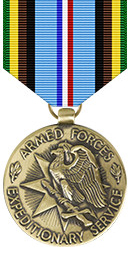Armed Forces Expeditionary Medal and Ribbon
History - Established 1961
Established on December 4, 1961, the Armed Forces Expeditionary Medal honors United States Armed Forces personnel who have confronted armed enemy forces or otherwise faced danger from hostile parties while carrying out service in or related to a U.S. military operation.
The award was originally intended to recognize service in Southeast Asia and in its initial form was presented for service in Vietnam. With the advent of the Vietnam Service Medal, however, the Expeditionary Medal was no longer issued for such service. The Expeditionary Medal remains active; however, In 1992, the creation of the Armed Forces Service Medal largely replaced the former. The Armed Forces Expeditionary Medal is now to be awarded solely for phases of service without any other corresponding campaign medal.
Eligible operations include those carried out by the United States on its own behalf, to support the United Nations or to support foreign allies.
Details
The medal features the image of an eagle in profile grasping a sword. Behind the eagle appears a compass rose with numerous rays extending out from between its points. Small sprigs of laurel appear on either side, and an inscription reading “ARMED FORCES EXPEDITIONARY SERVICE” encircles the medal. The reverse features the image of an American shield over two branches of laurel, and the words “UNITED STATES OF AMERICA” appear above the shield. The ribbon features three thin vertical stripes of blue, white, and red in the center flanked by thicker stripes of light blue. Proceeding outward toward the edge on each side are thin vertical stripes of black, brown, yellow, and green.
Bronze service stars may be issued to indicate subsequent awards, and streamers may be used to indicate service in designated areas. The arrowhead device and Fleet Marine Force device may also be issued for offshore or airborne operations as appropriate.
















